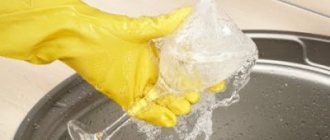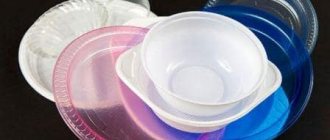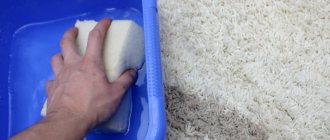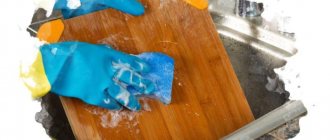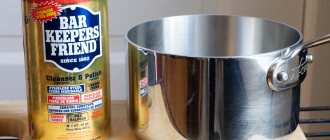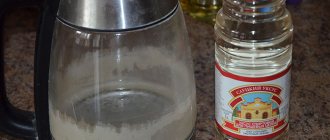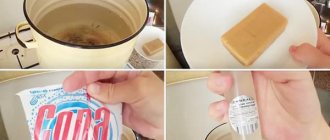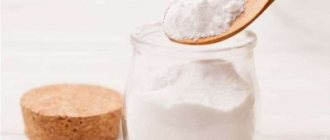Cleaning and boiling dishes is quick and easy. Read recipes for cleaning compounds in this article.
The utensils in which we cook food over fire require constant care. Burnt grease stains spoil the appearance of the dishes. It is not very aesthetically pleasing and unattractive when there are pots with a black coating in the kitchen.
- Carbon deposits can be so persistent that even the latest cleaning products cannot cope with them. How to remove such contaminants?
- Every kitchen has pots made from different materials: aluminum, glass, ceramics, enamel-coated and others.
- Any material has its own characteristics, so let's look at what effective detergents from the store exist, and what folk methods can be used to permanently get rid of burnt black deposits on dishes.
Dish boiling agent from the store: list
Fairy detergent
Now the store offers a large selection of innovative cleaning products. If you don’t want to bother with “grandmother’s” recipes: boil for a single day and wait a long time for the dishes to clean, then buy products in the store that are designed to clean carbon deposits and stubborn fat deposits.
Store-bought products are not intended for boiling dishes; they can only wash them. But many housewives, to be more effective, simply dissolve the product in boiling water and therefore lower the pots into this solution for 15-20 minutes. If the dirt is very ingrained and old, then you can leave the dishes in the solution overnight.
Here is a list of really effective dish cleaning products from the store, with which you can make a solution and soak the dishes for a long time in boiling water:
- Faeries
- Gala
- AOC
- Silit gel
- Winnie's
- De la Mark
- Calgonit Finish gel
It is enough to dissolve just a few drops of these products in water at a temperature of 90 degrees to get rid of old grease deposits on pans. But remember, if you work with store-bought products, then you need to follow safety precautions:
- Rinse items thoroughly after cleaning . Many cleaning products, especially gels, are difficult to rinse off.
- Work only with gloves to protect the skin of your hands from allergies.
- Ensure air flow - during cleaning in the kitchen, the window should be constantly open, at least for ventilation.
- Put on a respirator . If you have one, you should wear such protection when using a chemical cleaner. This will help protect the respiratory system from harmful fumes.
Sometimes the deposits on dishes are so persistent that even boiling with ordinary detergents is useless. Then housewives use aggressive products that are sometimes not intended for cleaning dishes. When using such “nuclear” weapons, you need to protect yourself by wearing a protective mask and gloves. Basically, two products from the store are used to remove stubborn dirt:
- “Shumanit” is a grease remover cream. Its action is fast, and it can dissolve even many years of carbon deposits on the surface. It only takes a few minutes, and the product will do an excellent job of removing dirt, leaving the dishes spotlessly clean. But remember that this product is highly toxic, so wear gloves and a respirator.
- Gel for cleaning sewer pipes. Such remedies are considered aggressive, but very effective. They must be stored in a place protected from children. Any plaque will be removed if you soak the dishes in a solution of 0.5 liters of this product and 5 liters of water. You need to keep the products in the solution for as long as possible until the dirt begins to come off the surface on its own.
Important: Be careful with non-stick cookware. Even one scratch can ruin a pot or pan and render it unusable.
For such dishes, it is better to use not store-bought cleaning products, but traditional methods of dealing with carbon deposits, which allow you to remove dirt without effort.
Important nuances
- Teflon cannot be cleaned using the methods described - the coating will be damaged and the dishes will become unusable and cannot be restored.
- Do not use soda with glue if the dishes have a shiny surface - they will become dull.
- Pre-unscrew pots and pans with wooden and plastic parts. If this is not possible, boiling is not advisable.
After alkaline cleaning, the non-stick coating is washed off. To prevent food from sticking to the surface, you will have to restore its beneficial properties.
How to boil dishes from grease and carbon deposits with stationery glue, soda ash: recipe
A pan cleaned with soda, laundry soap and office glue.
If you need to remove stubborn carbon deposits from the surface of the dishes without putting much effort, there is one recipe tested by many housewives.
- With its help, you can make a solution in which you just boil the dishes and the dirt comes off on its own - no need to clean or scrape. But the older the soot, the longer it will take to boil.
- To be more effective, you can leave the dishes in the solution until it cools overnight, and then all you have to do is rinse the clean surface with water.
- This solution is non-toxic, but its vapors can be harmful to an organism prone to allergies.
- Therefore, the boiling process must be done in the kitchen with the door closed and the window open.
Here is a recipe that helps clean dishes from grease and carbon deposits by boiling with office glue and soda ash:
What you will need:
- 30 liter tank . You can also use a 10-liter bucket, but then reduce the amount of ingredients by three times.
- Soda ash - 0.5 packs.
- Stationery glue - one bottle per 150-200 grams . The glue must be pure, without any PVA admixture - transparent, like glass.
Now do this:
- Grate one piece of brown laundry soap on a coarse grater. White soap will not work, only bars that were sold earlier in Soviet times - real brown soap, with a pungent odor.
- Now pour water into a 30-liter tank and turn on the gas.
- When the water is hot, add the grated soap and stir. At the same time add baking soda and glue. Stir the solution constantly to dissolve the soap and soda.
- When the solution boils, place the dishes in it. If the dirt is not persistent, then you will immediately see how it begins to come off. Black or brown plaque should be boiled for 15-30 minutes, and then the dishes should be left in this solution for several hours until they cool.
- If after a while you see that the dirt does not come off, then repeat the procedure the next day and boil the dishes, possibly in the same solution.
- After this, rinse the dishes under running water and continue to use them.
Important: This method is not suitable for cleaning aluminum cookware, as it may darken.
Recipe options
On the Internet you can find many variations of the recipe described above. Not all of them are equally effective, and some are completely useless:
- A solution consisting only of water and glue dissolves fats worse than one that includes all the ingredients. And replacing silicate glue with regular PVA is completely meaningless and negates the housewife’s efforts to put the dishes in order.
- Excluding laundry soap from the solution makes cleaning heavily soiled utensils more difficult.
- The use of sodium bicarbonate (regular soda, which is used in cooking) instead of sodium carbonate (soda ash) reduces the alkalinity of the solution, which also interferes with the normal softening of carbon deposits.
- But the most terrible mistake arises as a result of the similarity of the names of soda ash and caustic soda. The latter is caustic technical soda. The substance belongs to the second hazard class according to GOST 12.1.007. Caustic soda causes chemical burns upon contact with skin and severe corrosion of metals upon prolonged contact.
How to boil dishes from grease and carbon deposits with baking soda?
Dishes cleaned with baking soda
Less aggressive for cleaning dishes is baking soda. It can also be used to remove stubborn stains. It is necessary to boil the dishes to remove fat and carbon deposits with baking soda with the addition of 1 tablespoon of vinegar. Here is the prescription:
- Pour water into a 30-quart saucepan and dissolve 1 cup of baking soda.
- Add 1 tablespoon of 9% vinegar.
- Place the tank on the fire and stir until the soda completely dissolves.
- Then place the dishes in it and boil for half an hour.
- Then turn off the heat, and when the solution has cooled, remove the clean dishes from the tank and rinse with water.
This method is suitable if you take care of your dishes and there is no thick layer of old carbon on them. If the dirt is old, then use the previous recipe for cleaning the surface.
Cleaning with PVA glue
The recipe includes: PVA glue, water, soda, laundry soap.
Sequencing:
- Fill a bucket or basin with 4 liters of liquid and boil.
- Grind a third of a bar of laundry soap, pour into a container, pour in 2 tbsp. l. PVA, add 1 tbsp. l. soda
- Place the frying pan inside the container for half an hour.
- Take out the item to be cleaned and wash it with regular detergent under the tap.
Be sure to read:
How to dispose of a mercury thermometer at home if it breaks, where to put it
If the product cannot be boiled, this method will do:
- Fill a wide container with 10 liters of boiling water.
- Add 0.2 kg of PVA, 0.25 kg of soda, mix.
- Place contaminated items in the container for 1.5 hours.
- Remove the pans and clean them under the tap with a brush or cloth.
How to boil dishes from grease and carbon deposits with laundry soap?
Dishes cleaned of carbon deposits and grease with laundry soap.
Many people are allergic to soda ash, and therefore they cannot use products with it. But laundry soap also does an excellent job of removing plaque and old grease. Buy a bar of brown soap with a strong smell from the store and start removing dirt:
- To boil dishes from grease and carbon deposits with laundry soap, you need to put a large tank of water on gas.
- Then grate a bar of soap and dissolve the shavings in water.
- Add a little of any cleaning product (1-2 tablespoons), stir and dip the dishes into the solution. It should simmer in this product for at least 15 minutes.
- Then turn off the gas, cool the solution, remove the dishes and rinse with running water.
Remember: When boiling dishes in soapy water, the kitchen window must be open to allow air movement.
Reviews about the method
Anna, 26 years old
Recently I visited my grandmother in the village and decided to wash her old frying pans. There was nothing at hand from expensive means. I used baking soda and PVA glue. Is this possible? It turned out that yes. I made a hot solution and it turned out perfect! Now I will save money and clean everything in the kitchen. Cheap and cheerful, but most importantly - without any chemicals and does not spoil the dishes.
Arkady, 47 years old
Kitchen utensils are perfectly cleaned of grease with simple soda, stationery glue and hydrogen peroxide - this is an ideal product for cleaning dishes. The components are always at hand and there is no need to waste money. I boiled them in an old bucket, soaked them and that’s it – the pans are like new! My friends didn't believe it at first. One day we came in and I was making a soda-glue mixture. We saw her action in reality and gasped!
Christina, 62 years old
Washing soda is my all-purpose choice for every day, but a neighbor suggested that if you add laundry soap and simple liquid glue to it, you get a mixture for cleaning pots and pans from scale and grease. I tried it and was delighted! Now I call on this method to help every time the children come and cook barbecue. It is also ideal for skewers, grills and barbecues.
Store-bought cleaning products and dish powders: list
Procter & Gamble
The ideal cleaner should remove residue from the surface of your cookware within a few minutes. The foam that forms on a washcloth or napkin when using these products should be washed off well even with cold water. In addition, the product should have a low price.
Here is a list of the best dish cleaners and powders from the store:
- "Nefis Cosmetics"
- "Nevskaya Cosmetics"
- Procter & Gamble
- "Greenfield Rus"
- Alfatekhform LLC
- Winnie's
- "Harmony of Energy"
- De la Mark
- Sarma
- Fairy
- "Surprise for Cinderella"
Here is a list of the best products that do a great job removing stains from kitchen utensils in the dishwasher:
- Reckitt Benckiser
- Claro
- Frosch
Any of these products will cope with unstable pollution quickly and efficiently. After washing, the dishes will have a slight squeak and shine, like new ones.
How and what dishes can you clean with toothpaste?
Toothpaste
Few housewives know that toothpaste does an excellent job of removing greasy stains in the kitchen. It is even used to clean furniture facades, refrigerator surfaces and tiles. But how and what kind of dishes can you clean with toothpaste? Using this product, you can make dishes made from the following materials shine:
- Aluminum
- Steel with enamel
- Cupronickel
- Stainless steel
- Copper
- Cast iron
- Porcelain
- Faience
- Glass
- Nickel
- Ceramics
- Plastic
In general, almost all materials can be cleaned with toothpaste. It does not leave scratches and does not darken - this is an indispensable cleaning product for modern housewives. Apply a little paste to a napkin (if you are afraid that scratches will appear on the dishes) or a brush (for stainless steel, cast iron and other metal that is not afraid of scratches), and rub the surface of the pot, pan, spoons, forks and other items. Then rinse off the paste with water and you will see that the dishes sparkle like new.
Safety regulations
The ingredients and preparations are not dangerous to humans or pets. The main thing is not to add them to food or inhale them. To prevent components from entering the digestive tract, cleaning is performed away from children and animals.
It is not recommended to inhale the vapors of the ingredients during boiling. To prevent vapors from entering the respiratory tract, work is carried out in a mask or respirator.
Additionally, high-quality ventilation is provided, or at least the window opens.
How and what kind of dishes can be cleaned with ammonia?
Porcelain dishes cleaned with ammonia
Ammonia copes well with stains on glass, copper, cupronickel, aluminum, porcelain, earthenware, nickel-plated and ceramic dishes. This product can be either rubbed on the surface of dishes or dissolved in water with tooth powder. Ammonia dissolved in a small amount of water with the addition of lemon juice and water effectively cleanses dirt.
There are many recipes for preparing kitchen utensil cleaning products. All of them are effective and quickly remove carbon deposits. Create your own product recipes and share the secrets of quickly cleaning dishes. Good luck!
Recommendations
Expert advice will help you remove carbon deposits from the pan without damaging it:
- Special products in the form of sprays should only be used in conditions of good ventilation.
- Powdered cleaning products may leave scratches on the surface even if a soft sponge is used. Gel and liquid formulations are preferable in this regard.
- Before purchasing a household chemical product, you should study not only the procedure for working with it, but also clarify for which surfaces of the dishes the product is intended.
- You should not use a pan with carbon deposits that have not been removed for cooking, as this not only affects the taste of the food, but can also be harmful to health.
- Removing carbon deposits inside and outside the pan is a mandatory condition of operation, as it not only maintains the hygiene of the dishes, but also extends their service life.
The appearance of soot can be caused by insufficient cleaning of the pan before use, as well as physical defects in the coating.
Methods and means for cleaning various surfaces from carbon deposits are presented in this section.

